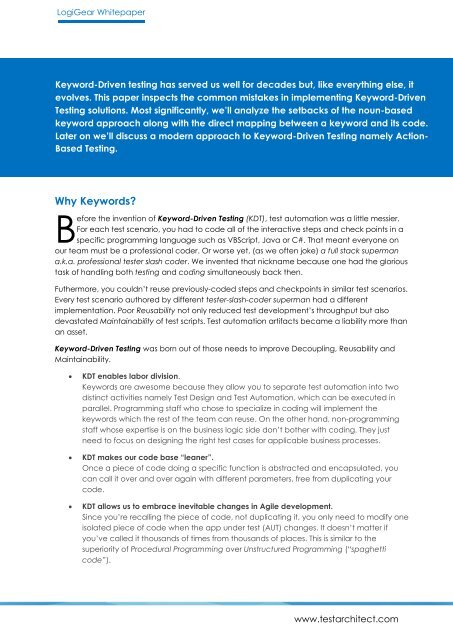The Evolution of Keyword Driven Testing
You also want an ePaper? Increase the reach of your titles
YUMPU automatically turns print PDFs into web optimized ePapers that Google loves.
LogiGear Whitepaper<br />
<strong>Keyword</strong>-<strong>Driven</strong> testing has served us well for decades but, like everything else, it<br />
evolves. This paper inspects the common mistakes in implementing <strong>Keyword</strong>-<strong>Driven</strong><br />
<strong>Testing</strong> solutions. Most significantly, we’ll analyze the setbacks <strong>of</strong> the noun-based<br />
keyword approach along with the direct mapping between a keyword and its code.<br />
Later on we’ll discuss a modern approach to <strong>Keyword</strong>-<strong>Driven</strong> <strong>Testing</strong> namely Action-<br />
Based <strong>Testing</strong>.<br />
Why <strong>Keyword</strong>s?<br />
B<br />
efore the invention <strong>of</strong> <strong>Keyword</strong>-<strong>Driven</strong> <strong>Testing</strong> (KDT), test automation was a little messier.<br />
For each test scenario, you had to code all <strong>of</strong> the interactive steps and check points in a<br />
specific programming language such as VBScript, Java or C#. That meant everyone on<br />
our team must be a pr<strong>of</strong>essional coder. Or worse yet, (as we <strong>of</strong>ten joke) a full stack superman<br />
a.k.a. pr<strong>of</strong>essional tester slash coder. We invented that nickname because one had the glorious<br />
task <strong>of</strong> handling both testing and coding simultaneously back then.<br />
Futhermore, you couldn’t reuse previously-coded steps and checkpoints in similar test scenarios.<br />
Every test scenario authored by different tester-slash-coder superman had a different<br />
implementation. Poor Reusability not only reduced test development’s throughput but also<br />
devastated Maintainability <strong>of</strong> test scripts. Test automation artifacts became a liability more than<br />
an asset.<br />
<strong>Keyword</strong>-<strong>Driven</strong> <strong>Testing</strong> was born out <strong>of</strong> those needs to improve Decoupling, Reusability and<br />
Maintainability.<br />
<br />
<br />
<br />
KDT enables labor division.<br />
<strong>Keyword</strong>s are awesome because they allow you to separate test automation into two<br />
distinct activities namely Test Design and Test Automation, which can be executed in<br />
parallel. Programming staff who chose to specialize in coding will implement the<br />
keywords which the rest <strong>of</strong> the team can reuse. On the other hand, non-programming<br />
staff whose expertise is on the business logic side don’t bother with coding. <strong>The</strong>y just<br />
need to focus on designing the right test cases for applicable business processes.<br />
KDT makes our code base “leaner”.<br />
Once a piece <strong>of</strong> code doing a specific function is abstracted and encapsulated, you<br />
can call it over and over again with different parameters, free from duplicating your<br />
code.<br />
KDT allows us to embrace inevitable changes in Agile development.<br />
Since you’re recalling the piece <strong>of</strong> code, not duplicating it, you only need to modify one<br />
isolated piece <strong>of</strong> code when the app under test (AUT) changes. It doesn’t matter if<br />
you’ve called it thousands <strong>of</strong> times from thousands <strong>of</strong> places. This is similar to the<br />
superiority <strong>of</strong> Procedural Programming over Unstructured Programming (“spaghetti<br />
code”).<br />
www.testarchitect.com


